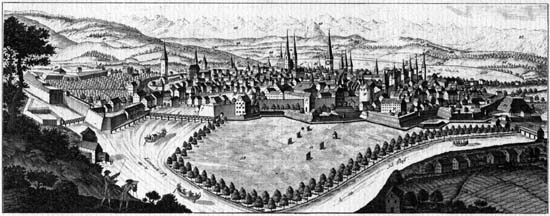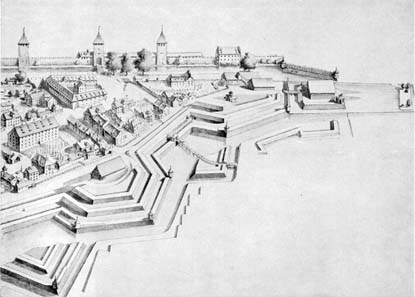The People of Zurich and their Money 12: the walled city
by courtesy of MoneyMuseum
Our series “The People of Zurich and their Money” takes you along for the ride as we explore the Zurich of times past. In April 1833, a young man explained to his spouse why the Zurich fortifications, on which they took a stroll, had to be battered down under all circumstances. Much like a good DVD, this conversation comes with a sort of “making of” – a little numismatic-historical backdrop to underscore and illustrate this conversation.
Jakob takes his fiancée Berta for a walk. Drawn by Dani Pelagatti / Atelier bunterhund. Copyright MoneyMuseum Zurich.
Jakob: Now it’s agreed, Berta. They will pull down the fortifications.
Berta: Pa told me about it. He thinks it to be a scandal that Zurich will be defenseless and in its enemies hands. And all the money it’ll cost. Pa mentioned numbers which made my head spin.
Indeed, there are politicians who estimate the costs of flattening the entrenchments at nearly half a million Francs. Berta, imagine, this means more than 30 million shillings!
30 million? Good God.
But you shouldn’t believe that, my darling. These are estimates of people who balk at progress! They try to frighten us with these numbers. We worked out that it won’t cost a rappen to pull down the walls.
Really, Jakob?
Listen, Berta, these fortifications on which we are walking, they occupy a lot of space.
That’s right, Jakob.
And this space is precious: houses could be built on it, factories and of course streets. The inhabitants of Zurich will scramble to buy these building sites. And the money we earn by selling them will finance the demolition. And of course we shouldn’t forget the political dimension.
Of course not, Jakob.
For centuries the city of Zurich has held sway over the countryside. The rural municipalities were so fed up with being suppressed. Now every inhabitant of the canton of Zurich is equal. And some are afraid that reactionary forces could try to overthrow this regime. They think the fortified city to be a permanent menace. And, in the end, think of the operating costs.
Indeed, Jakob.
Delegate Rieter calculated that the maintenance of the fortifications cost 600,000 francs within the last 30 years. Listen, for education we spent 200,000 francs within the same period! Isn’t that horrible!
Horrible, Jakob, indeed.
(enthusiastic) And it’ll be wonderful for our economy, when the goods can enter the city without having to pass a barrier. How much time will be spared, how much costs! We now can proove how modern Zurich is. And who knows, perhaps we can buy a cheap building site. And then I’ll build a house for my Berta.
O Jakob, you’re so clever. But nevertheless, these marvelous fortifications. Isn’t it sad that they’re useless now? It must have been a lot of work to build them. And they certainly cost a lot of money.
Zurich. Schanzenthaler, late 17th / early 18th century. Künker 184 (2011), 5753.
Making of:
„And surely they had cost a lot of money” – these words conclude our audio drama on the fortifications of Zurich. As a matter of fact, we know exactly the cost of their building between 1642 and 1677: 1,863,800 pfund, 17 shillings and 9 heller, but of course that doesn’t mean anything to us anymore. So, let’s try a different approach: an ordinary construction worker, like the ones working on the site in hundreds, earned 16 shillings a day in 1642. That was an extremely good salary due to the fact that there was a universal lack of working forces at the end of the 30 Years’ War. The total cost of the building equaled, given this high a wage, 1,000 men working for six years and four months without interruption – which they didn’t, needless to say. On the contrary, since more than once there were longer periods of time when the city couldn’t finance construction work. In 1677, too, the sconces weren’t finished. As late as the final decade prior to the decision to batter down the fortification walls of Zurich, work was continued. Thus, the sconces, which shaped the Zurich cityscape, were a vanity project that cost an arm and a leg. Its military effect, however, was in dispute. It comes as no surprise that a possible demolition of the walls was subject for debate in the 19th century, a time when costs and benefits were considered very carefully.
Cityscape of Zurich from 1724 after Johann Melchior Füssli. It was part of a wall calendar republished in several editions since 1724. Source: David Herrliberger / Wikipedia.
The first public demands for the fortifications being battered down were voiced on September 3, 1828, in the context of a budget debate in the Great Council. There can be no doubt that this request was related to the attempt to save the costs for the public budget generated by the preservation of the fortification walls. But soon other, political arguments pushed themselves to the fore.
Strong Zurich had kept the surrounding communities under for centuries. After the Helvetic Republic had failed in September 1802, the state authority of Zurich proved once more which means it was willing to resort to in order to secure its power. The walls became a symbol of the municipal tyranny. Unsurprisingly, after the demonstrations of 1830 and after a new, liberal constitution for the Canton of Zurich had been enacted in March 1831, it was demanded that the city walls were battered down as a visible sign for the equal status of city and country.
When a conspiracy of unprogressive forces in the liberal city of Bern was revealed, the Zurich rural communities believed that in Zurich, too, conservative forces were active that could only be controlled by tearing down the sconces. Consequently, the petitions for battering down the Zurich walls for good became more and more frequent since 1832.
These requests were read aloud in the Great Council on September 28, 1832. They prompted a quite emotional debate with liberal politicians emphasizing the economic advantages coming with the demolition of the walls. They referred to the fortifications as an obstacle to the growth of industry and commerce. Their opponents, who enjoyed great support of much of the Zurich municipality, pointed out how important, militarily speaking, Zurich was in regard to the safety of entire Switzerland. And they tried to beat their economy-oriented adversaries at their own game. In the concluding debate, old governing council von Muralt took the high cost a demolition of the Zurich city walls would generate as an argument: according to his calculation, they added up to 596,031 franks – a sum that would have been faced with only 104,500 franks of revenues the city would gain by selling the premises hitherto occupied by the fortifications. Thus, the city of Zurich was left with costs adding up to 491,531 franks. That was quite a sum. For comparison: only three years later, Johannes Baur had 257,000 Swiss franks at his disposal for building his Hotel Baur en Ville.
Fortification system around present-day Parade Square in the 18th century. Central library Zurich. Source: Wikipedia.
The members of the Great Council were undeterred by the calculation of the campaigner for the sconces. On January 30, 1833, they adopted the motion (131 votes for and 53 votes against) to batter down the fortification walls. The work started on April 2, 1833. It took almost 27 years for the citizens of Zurich to learn the true cost of the battering down of the fortification system. It was a surprising result: 1,715,621.89 franks had been spent – more than three times the estimate of the ones opposing the fortification walls! That sum, however, was faced by 1,719,908.33 franks that had been collected by selling the building plots on the former sconces ground – the considerable restraint of the buyers from Zurich notwithstanding. Zurich, therefore, was able to enter a profit of 4,286.44 franks in the books and, in addition, possessed building worth approximately 150,000 franks on redoubts area as well a 600,000 square foot, i.e. almost 53,000 square meter, of building land. So, battering down the sconces had been a pretty good business.
In the next episode you will be introduced to a clever cashier who managed to rob the Zurich branch of the Union Bank of Switzerland in 1869.
You can find all other parts of the series here.
The texts and graphics come from the brochure of the exhibition of the same name in the MoneyMuseum, Zurich. Excerpts with sound are available as video here.









